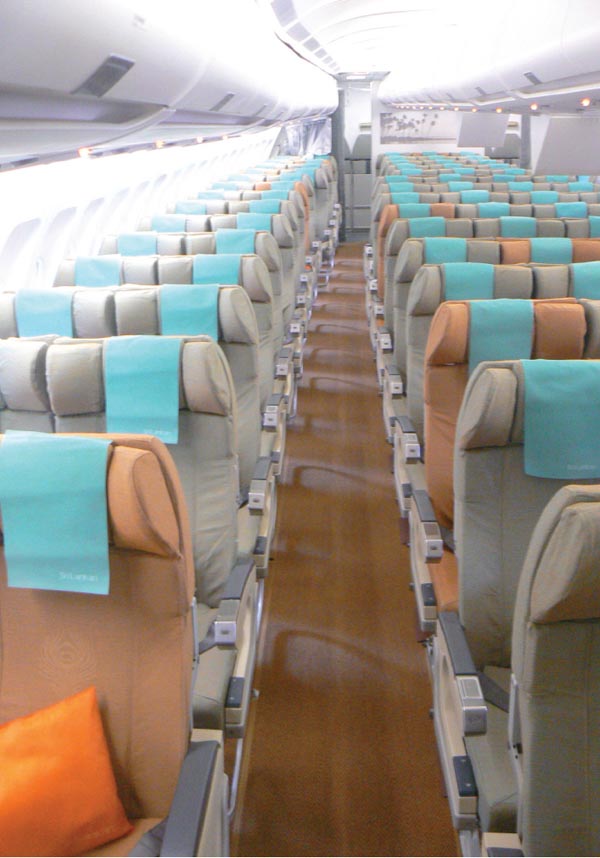-
Taking Design To The Skies
January 2013

It’s not every day that a designer is given the opportunity to create a visual space in the sky. This was both the opportunity and challenge that was presented to Archt Madhura Prematilleke and his team at team ACHITRAVE by Sri Lankan Airlines who wanted a new cabin interior created for their Business and Economy class passengers.
By Manori Wijesekera | Photography Kesara Ratnavibhushana
The brief was to provide passengers with a contemporary, soothing and relaxing ambience which would also be uniquely Sri Lankan, while creating a setting for the cabin staff in their new uniforms. Expanding the visual spaciousness for both classes of passengers was also important to the client. Every item in the cabin interior had to be purpose-designed, including carpets, fabrics, cabin bulkheads (wall linings), curtains, cushions, and accessories.
“This was an unusual project for us, I hadn’t even dreamt of doing something like this,” recalled Archt Madhura Prematilleke who led the project team. The project was a collaborative effort with Gihan Nanayakkara of Orient Design. “Gihan and his team brought in the much-needed expertise and understanding of fabrics, weaving and even stitching,” said Archt Prematilleke. And since Nanayakkara had designed the new cabin crew uniforms, his input to the project brought in a sense of continuity to the new image being created by Sri Lankan Airlines.
The main emphasis in the Business Class cabin was to create a very relaxed flying experience for passengers. An early decision that had to be made was the colour of the leather seats for Business Class as these reclining seats were being newly ordered. Providing the client with colour combinations and options, the team was pleased to see the client finally selecting their own preference – terracotta brown. “Terracotta is the colour of the tiled roof and the Sigiriya frescoes, and this colour comes from our architectural roots,” said Archt Prematilleke.
The carpeting for the Business Class cabin was inspired by the patterns of traditional Sri Lankan Dumbara mats. Working with the manufacturers in UK – the designers produced a terracotta-hued carpet with sections of Dumbara design. Another traditional Sri Lankan element – the bata pelali, or bamboo tats – was incorporated into the cabin wall design. “Since horizontal lines are more restful and create a sense of space, we developed a whole series of patterns based on this concept,” said Archt Prematilleke. The subtle bamboo tat design goes across the cabin walls, while the bulkhead panels have a stylised image based on photographs of Sri Lankan birds, animals and landscapes to create an illusion of looking outdoors through a bamboo tat. This pattern was also continued on the grey curtains which separate the two cabins.
The inspiration for the Economy Class cabin was the beaches and ocean around Sri Lanka. “We used the golden beaches and indigo-blue seas as our inspiration and added a very Sri Lankan element to the carpeting,” said Archt Prematilleke. This element was the lanu peduru or coir mats. Experimenting with different weaves over a period of time, the team was finally able to create the carpet weave in the colour, texture and effect they desired. “We had to figure out how to get a 2-dimensional carpet weave to recreate a 3-dimensional mat weave, which was not easy.”
While the wall panel design continued from Business Class, creating a common element between the cabins, the fabric for seats and accessories in the Economy cabin remained unique.
A contemporary-designed fabric, continuing on the horizontal grain was specially created with a stylised, ingrained peacock feather motif woven into the fabric.
“The horizontal grain added to the sense of spaciousness and light, and the colours of gold and blue scattered throughout the Economy cabin create a contemporary and welcoming ambience,” said Archt Madhura Prematilleke.
All the designs were tested dozens, perhaps hundreds of times, in a specially created mock-up cabin. The mock-up had 4 – 6 rows of seats, cut outs of cabin staff in their new uniforms and the same wall shell and lighting as the aircraft. The project team spent hours at a time in this space, testing each element over and over again, within varying conditions.
Commissioned for this project in May 2010, the new look was launched in August 2011 by
Sri Lankan Airlines. “The biggest challenge from a design point of view was visualising everything together within this confined space,” recalls the Architect.
“But we learned to stay true to an identified concept, perhaps more so than in an architectural project,” said Archt Prematilleke. With each new element, each change, the team came back to their core concept. Designing within a very confined environment was a new experience for the team from which the whole team learnt from. “We had to understand the whole psychology of people spending a prolonged time in a confined space,” he said. The design team also had to work with multiple manufacturers and their teams, overseas and in Sri Lanka. Archt Prematilleke, in particular, found the experience of working with multiple design teams in creating a specific product, a rewarding one.
A lesson learnt from this exercise is that an Architect’s abilities can be applied to a wide range of design tasks. “We found that our conceptual skills about space and structuring a visual experience, which come from our architectural roots, were essential skills in this project.”
Design Firm: team ACHITRAVE with Orient Design
Project Designers: Madhura Prematilleke
Collaborative Designer: Gihan Nanayakkara
Date of Completion: August 2011
Project Period: May 2010 – August 2011
Client: Sri Lankan Airlines















